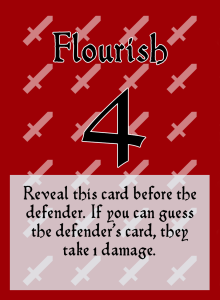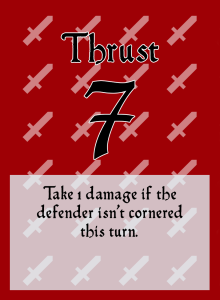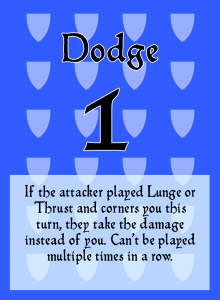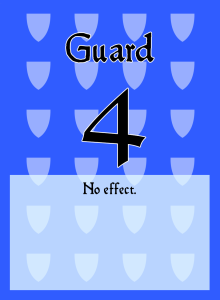If you’re reading this, you’ve probably seen the boxart for Happy Daggers! It’ll be out on The Game Crafter within a few weeks, and our first convention appearance with it in tow will be at GX3 in December.
“But wait, Jeremy, what is Happy Daggers even about? How do I play it?” Glad you asked! In a nutshell, Happy Daggers is meant to simulate the kind of dramatic swordfight you see onstage or in the movies. The two fighters leap around the stage, trading attacks one at a time, until one of them inevitably runs out of room to maneuver and gets stabbed in the way that generates the most pathos.
The key mechanic of Happy Daggers is the repertoire – a group of sword moves that you select at the start of the game. There are five Attack cards (red) and five Defense cards (blue), each of which has its own strengths and disadvantages. You get to choose three of each, and can’t switch them out. Let’s look at a few!
Each turn, players switch between being on the attack (and playing an Attack card) and being on the defense (and playing a Defense card). Both players play cards face-down and reveal them simultaneously, with the exception of Flourish, which gets revealed first.
Before we go any further, let’s look at a stage!
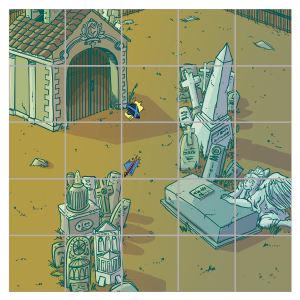
The Capulet Tomb is the simplest stage in the game. The most important thing to notice is all the dead ends – these are going to be the main way you’ll deal damage to your opponent. Incidentally, the sword and shield cards are where the player who attacks first and the player who defend first start, respectively.
After applying your cards’ effects, if the attack card has a higher value (the big number in the center) than the defense card, the attacker pushes the defender away from them a number of squares equal to the difference, plus a bonus that I’ll talk about in the next update. However, if there aren’t enough squares to push the defender, they’re cornered and take 2 damage! Each player can take 8 damage before they expire.
Here’s some more fun facts about attack and defense cards:
- Attack cards’ values range from 2 to 7, while Defense cards’ values range from 1 to 5. This means that, on average, the defender will get pushed at least a few squares. This doesn’t mean that defending with high value cards is necessarily useless, though! If you can limit your opponent to moving you a square or two, you can gradually force them into the corner.
- The lower a card’s value, the more powerful its effect. In fact, the most powerful Attack and Defense cards will deal damage to you. Thrust, above, is one of them.
Join me tomorrow for an explanation of Dramatic Tension, Irony, and a peek at one of the dramatis personae!
–Jeremy
